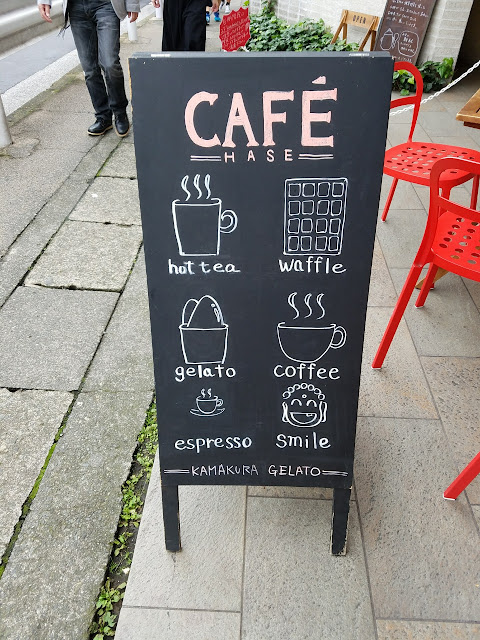Edit 3 October 2019: Updated prices to reflect the increase in Japan's national sales tax.
Of the many temples and shrines in Kamakura, only one seems to have risen above the competition to become the iconic symbol of the city: Kotoku-in (高徳院, Kōtoku-in). Or, to be more specific, its giant bronze Buddha statue (大仏, Daibutsu).
As described below, the easiest way to get to Kotoku-in is by the Enoshima Electric Railway (江ノ島電鉄, Enoshima Dentetsu) tram line, departing from Kamakura Station. They use a varied fleet of cars, from newer models to ones dating back to 1960. This one is a newer, yet retro-styled, model from 2002.
Some of the tram cars have unique liveries, such as this one painted with images of their mascot. One of them can be seen doing horseback archery, a yearly tradition at the nearby Tsurugaoka Hachiman shrine.
On my way up to the temple, I passed this cafe whose menu offered, among other things, "smile", illustrated by a cute drawing of the Buddha's face.
The entrance gate looks unassuming, but the centrepoint of this temple is not far beyond.
A pair of marble koma-inu (狛犬), or lion-dog statues that symbolically guard the entrances to shrines and some temples. Yet for some reason, the gate they stand watch over is closed to visitors; instead, you make your way to the left, and pay at the counter, to enter the temple grounds.
You know, I've started to notice that Shinto shrines are usually free to visit, whereas Buddhist temples, at least the larger ones, charge for entry. They're usually cheap, with Kotoku-in costing only ¥200 (US$1.80) to get in, but if you intend to visit a lot of temples in a day, they can add up.
And here it is! The statue is 13.35 metres (43 feet, 10 inches) tall, including its base, and despite being hollow, weighs 121 thousand kilogrammes (133.3 US tons). It has been described as the second-tallest bronze statue of a seated Buddha in Japan, before the one at Todai-ji in Nara. But, I've gone over the list of Daibutsu statues, and... that's not true. There are quite a few that are taller than either of the two more popular ones. Most of those, however, were erected more recently, so the first and second-place appellations may have belonged to Nara's and Kamakura's Buddhas at some point, and their reputation stuck. Still, whatever its ranking, this statue is no less impressive. Why, the ears alone, at 1.9 metres (6' 3"), are taller than most people!
Today, the statue stands out in the open, but in its earlier years, there used to be a hall sheltering it. These buildings had a habit of burning or falling down, however; the third and final hall was destroyed in a tsunami in 1498, and no one bothered to rebuild it after that. Also, if you look really closely at the cheeks, you may also find flecks of gold colouring, suggesting that the statue may have been covered in gold leaf at some point in its history. Could you imagine that...?
For a tiny fee, you are welcome to go inside the statue. It's not terribly big in there, and indeed was cramped from the volume of people when I visited. But doing so gives you a close-up view on the construction of this statue.
A plaque inside describes some of the techniques used in the statue's construction. Considering that it is over three-quarters of a millennium old, this is an amazing feat of engineering!
Kotoku-in has its own pair of giant o-waraji sandals, just as I saw at Senso-ji a couple of days before. Each one measures 1.8 by .9 metres (5' 11" by 2' 11") and weighs 45 kilogrammes (99 lbs.). They were donated to the temple by the Matsuzaka Children's Club of Hitachi-Ota city, Ibaraki prefecture. The first pair was offered in 1951, with wishes for peace and recovery after World War II, and replacements were sent roughly every three years thereafter.
There were a few flyers posted on the walls of the complex by its staff, including this one for a speech given by the Dalai Lama in Yokohama. A summary of the speech is included on the poster, translated to Japanese, Chinese, and English. I thought I'd share it with you because I found it inspiring.
Several kings and princes of Thailand, another majority-Buddhist country, have also made pilgrimages here, and planted commemorative pine trees to mark their visits.
Here's a close-up of an informational plaque in front of one of those pine trees, helpfully translated to Thai, English, and Japanese. In this case, it states that Thailand's ambassador to Japan replanted a tree in that spot in 2010, replacing the original planted by King Rama VI over a hundred years ago.
I imagine the Buddha must have blessed my visit, too, because as I was about to leave, the sky finally cleared up! The change cleared up my spirits, too, so I wanted to take another snap of the Daibutsu in the improved lighting before leaving to my next destination: Hase-dera Temple. Read about it, next time on Sekai Ichi!
Hours: Open 8:00 AM to 5:30 PM from April through September; closes at 5:00 PM from October through March. The statue interior closes at 4:30 PM. No regular closing days.
Costs: ¥300. Entry to the interior of the statue costs an additional ¥20.
Address: 4-2-28 Hase, Kamakura-shi, Kanagawa-ken 〒248-0016
Access: From Kamakura Station, take the Enoshima tram (EN) line to Hase (EN12, 5 minutes, ¥200). Kotoku-in is 7 minutes on foot from Hase Station.
Directions: From Hase Station, turn right onto the main road, and follow it uphill for about 7 minutes. The temple entrance will be on the left.
Website: (English) (Japanese)















